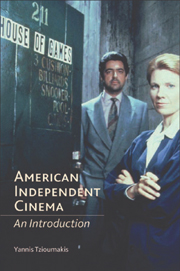Book contents
- Frontmatter
- Contents
- Analytical Table of Contents
- List of Tables
- List of Case Studies
- List of Figures
- Acknowledgements
- Dedication
- Introduction: Problems of Definition and the Discourse of American Independent Cinema
- Part I American Independent Cinema in the Studio Years (mid-1920s–late 1940s)
- Part II The Transitional Years (late 1940s–late 1960s)
- Part III Contemporary American Independent Cinema (late 1960s–present)
- Epilogue: From Independent to ‘Specialty’ Cinema
- Bibliography
- Index
Epilogue: From Independent to ‘Specialty’ Cinema
- Frontmatter
- Contents
- Analytical Table of Contents
- List of Tables
- List of Case Studies
- List of Figures
- Acknowledgements
- Dedication
- Introduction: Problems of Definition and the Discourse of American Independent Cinema
- Part I American Independent Cinema in the Studio Years (mid-1920s–late 1940s)
- Part II The Transitional Years (late 1940s–late 1960s)
- Part III Contemporary American Independent Cinema (late 1960s–present)
- Epilogue: From Independent to ‘Specialty’ Cinema
- Bibliography
- Index
Summary
Throughout the decades of the twentieth century the discourse of American independent cinema has expanded and contracted to include a wide variety of production and distribution practices, a diverse array of aesthetic strategies and an immense range of films: from the top-rank films distributed mainly by United Artists in the 1920s, 1930s and 1940s to the Poverty Row quickies; from the high-budget independent films of the hyphenate filmmakers of the 1950s and 1960s to the cheaply produced youth-oriented genre films of the same period; from the New Hollywood films of the 1970s to the exploitation fare of companies like AIP and Crown; from the new political filmmaking of the late 1970s to the mini-majors and major independents of the 1980s to the outburst of low-budget filmmaking in the 1990s and 2000s, which arguably reached its peak with the release of Tarnation (Caouette, 2004), the Sundance sensation of 2004, which allegedly cost just $218 to produce.
Despite the existence of commercial independent filmmaking throughout the history of American cinema, it was only in recent years (the post-1980 period) when this type of cinema was widely perceived as an alternative proposal. This was mainly because from the late 1970s onwards mainstream American cinema started placing particular emphasis on the production and distribution of franchise films with great potential for further reiteration in the ancillary markets and on star-driven genre films that were guaranteed to deliver particular audience demographics.
- Type
- Chapter
- Information
- American Independent CinemaAn Introduction, pp. 281 - 284Publisher: Edinburgh University PressPrint publication year: 2006



